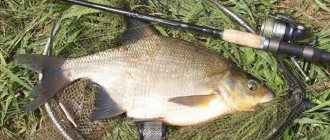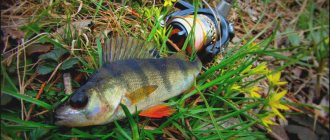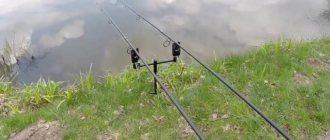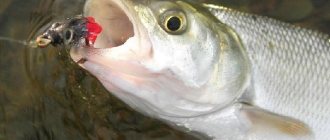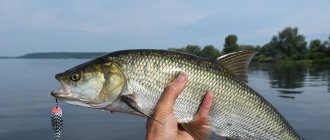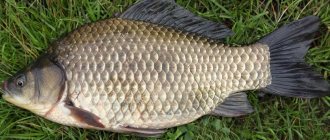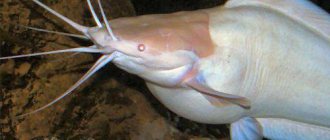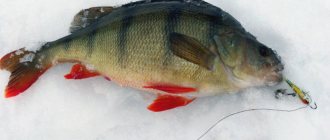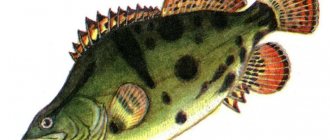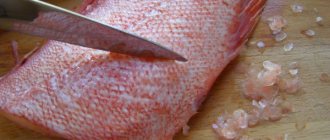Features of behavior
In different bodies of water, perch has different habits. In summer, these fish gather in schools. The smaller the waterfowl, the more numerous their schools. At this time of year they are very active in water temperatures ranging from 17°C to 23°C. To maintain their intense life, they need energy. Because of this, the biting frequency increases. But if the reservoir heats up more, then their liveliness begins to subside.
Since the water is warmed up almost everywhere, perches do not choose special places to stop. They are equally comfortable everywhere. But more often they live in places with a hard bottom, where there are numerous changes in relief, as well as in areas overgrown with grass.
This is where fry most often live, so predators try to look for food here.
In summer, each individual hunts separately, since it is unwise to look for fish in a group.
The bite on the river is good throughout the day . At this time of day, they fiercely attack forage fish and literally drive them into the coastal edges. If there are reeds nearby, then the fisherman can sometimes see that they are literally teeming with small roach or bleak. But large perches are most often caught at night.
On ponds, perch almost never hunts during the day . At this time he hides in the shadows. Even if the bait is literally in front of your nose, you still won’t get a reaction. It is best to catch minke whales in such reservoirs from morning until lunch.
Weather influence
Pressure
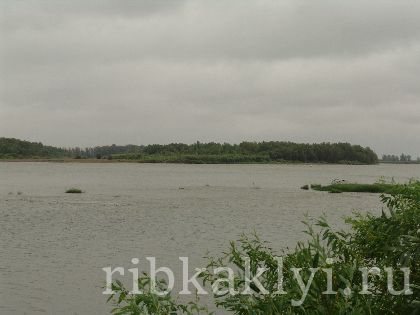
Atmospheric pressure is of great importance for the perch bite; at low constant pressure, the perch is very active and takes well to any decoys. He is sensitive to sudden changes in blood pressure and refuses to even take food that falls on his head. High constant water does not cause much hunger, although the perch continues to feed.
Precipitation
A surge in predator activity is observed before and after a light rain. It takes bait well during short-term rains during the day.
Wind
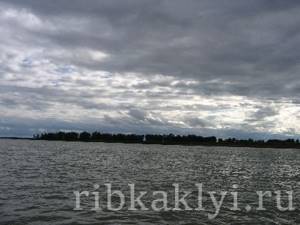
Fishing for perch in summer, among other things, is affected by both the strength and direction of the wind. With moderate, non-strong, creating ripples, the predator's zhor increases. South and west also have a good effect on activity. The east wind has the worst influence. The northern one is not much different from the eastern one. Frequent changes of direction can completely discourage the fish from biting.
Water temperature
Peak activity of perch occurs at water temperatures of 8-20 degrees Celsius. A change in one direction or another has a depressing effect on the striped fish; it becomes lethargic and bites weakly.
Times of Day

When hunting, perch relies more on vision, so it feeds during daylight hours. In summer, when the water warms up above 20 degrees, it is almost impossible to catch fish during the daytime. If the weather is sunny, small and medium-sized specimens hide in the shade of algae, trees or banks. Large, it sinks into holes to a depth of 4-5 meters and there it waits out the summer heat and direct sunlight, getting out to fatten at dawn and evening, or on rainy days.
Habitats
- Small individuals can swim in any part of the reservoir at any time of the year.
- But larger specimens live in shallow holes with vegetation in hot weather. And the higher the temperature, the deeper the depression is needed. They can also hide where tree crowns hang.
- Perches also like to live near hydraulic structures of various types, with supporting structures of bridges, with embankments of stones and boulders with snags. If there is a current, then it does not scare the striped fish. He lives a little further from the current itself.
- Perch feed on fry, and they live in the coastal zone, so it often appears here.
- On large lakes or ponds, the predator can be found where seagulls fly. The fish, fleeing from being eaten, swim to the surface of the water. And then the birds catch them.
Behavior and summer habitats
Perch has rightly earned the title of the most ubiquitous fish. After spawning, it can be found anywhere, even among the roots. Large perch are easy to find in deep places, unlike small specimens that are confined to shallow bays.
As for hunting, the predator does this even in the presence of a strong current. In hot weather, the perch concentrates under the canopy of trees or under the leaves of the egg capsule. Naturally, his activity decreases, and he monitors his prey from behind his secluded ambush.
Perch is considered a diurnal predator; only on days of high temperature does it prefer to feed at dawn (like pike perch). On large bodies of water it can be seen by focusing on a concentration of seagulls, because the fish squeezes out all sorts of small things to the surface. And for seagulls it becomes excellent food.
Fishing for perch on the river
The most important question that many fishermen ask is: “How and where can I find perch on the river?” The most successful places can be considered the recesses under the plates, a little away from the stream. It can also be found on the reverse current. This is explained very simply - a stormy stream throws out small fish, which become easy prey for perch.
Important! The main aspect of summer perch fishing is the oxygen factor. Fish are very sensitive to a lack of oxygen and leave places where conditions are unfavorable for them.
Lake perch fishing in summer
On lakes, small perch can be found in shallow water areas near sparse vegetation. Such places are often inhabited by potential prey of perch, which swims here to feed. At the same time, the vegetation creates favorable conditions for hiding the predator. But where even the young fish don’t stay, you won’t find perch. These are primarily extensive sandy bays with a depth of less than 50 cm.
Usually large perch choose deep places. The exception is areas where a thermocline forms (a sharp change in temperature at a depth of more than 2 m). On summer days on the lake, the bite begins after the sun has risen, and the harbinger is a school of small fish near the shore. This is exactly what our predator will come out to hunt. By lunchtime the bite weakens or disappears completely.
Perch boiler
This concept is known even to novice fishing enthusiasts. A school of perch forms an arc and begins to drive small fish onto the shallows. As a result, the fry finds itself in a difficult situation: on one side there is the shore, and on the other there is a flock of predators.
The perch cauldron can be seen even from a great distance, because... a predator in a pack becomes incredibly active, which makes it vulnerable. This is the most promising fishing during the warm period. You can only use a spinning rod; the color of the bait does not matter.
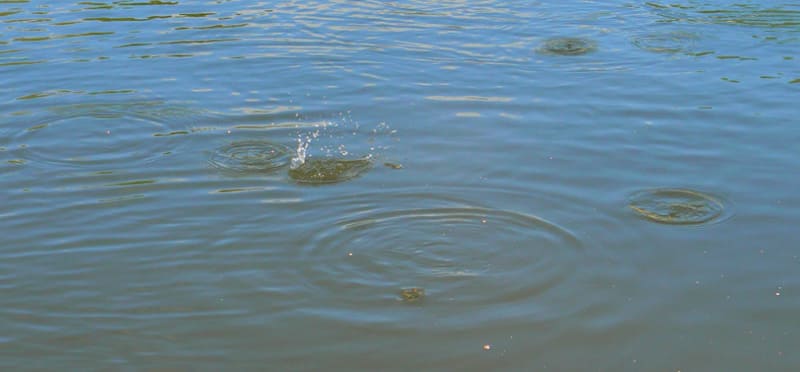
perch boiler
Summarizing the habitat, let us generalize that small perch prefers shallow water; it does not swim in dense thickets, but it cannot be found in completely open spaces.
Biting calendar by fishing season
To successfully catch perch, every angler must know what time it is most active. And also how weather conditions affect his capture. When the lunar phase changes, the striped fish also reacts to this and may not peck.
- In spring , the predator is well caught in early March and until mid-April. As soon as the ice breaks, the perch begins to actively hunt for everything that moves. Therefore, at this time it is worth catching it with small spoons. Spawning occurs during this season. And you can often catch a large specimen weighing up to 1.6 kg using a spinning rod.
- In summer , perch is fickle and bites differently. Therefore, each time you need to experiment with baits and places of capture. This season, stripers are good from June to mid-July, preferring bright and shiny baits. A wobbler gives good results, as it well imitates the movement of real fish.
- In September, perch may not bite consistently. But in October-November they begin to become hungry, and they hunt quite energetically, reacting to any bait, including live bait. The predator is caught in the fall throughout the day, but more can be caught early in the morning. It is also good to catch stripers with live bait after rain. To successfully catch a predator in the fall, you need to use bright small and medium-sized spoons (spinners, twisters, vibrotails), or well-known wobblers.
- Many fishermen successfully catch in winter , although the process itself differs from summer catching. It bites during the daytime, but there are also good catches in the evening. During this season, the striped fish hunts a lot on warm days. In cold weather it is not so active and it is more difficult to catch it.
Perch tackle
The fish has excellent vision, so the fisherman’s tools play an important role in the catching process. The larger the bait, the easier it will be detected by fish at a distance. Noise can also attract them.
Float tackle
The best place to use float rods: a high steep bank. The desired prey will definitely be prowling at its foot at dawn. A moderately hard fishing rod – match, Bolognese, fly or plug – will allow you to catch it.
The recommended set includes: hook No. 8, a heavy and bright float, a sinker attached at a distance of 15-20 cm from the hook, fishing line with a diameter of 0.3 mm.
Read more: How to catch perch using float tackle
Donkey
A solution for those who are determined to catch the “muzzle”. Large individuals are quite shy and cautious, so the most sensitive equipment is selected for them. Quality must be present at the rod tip. This model perfectly captures even the slightest bites.
In still water, it doesn't matter whether the weight is flat, round or olive. Any option will do. For fishing from a boat, a rod about 0.5 m long and an inertial reel are useful. And the best bait is live bait.
Read in more detail: About catching perch on a donk
Spinning
For catching perch in the summer from a boat, models up to 2.1 m in length are more suitable. The design and test of the product are selected based on the parameters of the bait, as well as the size of the expected prey. When using small wobblers and spinners, you can opt for a lightweight version of the spinning rod with the following parameters:
- action: fast/medium;
- length: 180-200 mm;
- test: 2-15 g.
Models up to 2.7 m long are designed for catching perch in the summer from the shore. Maximum test: 20 g. The action should be fast or medium.
Read in more detail: About catching perch with a spinning rod
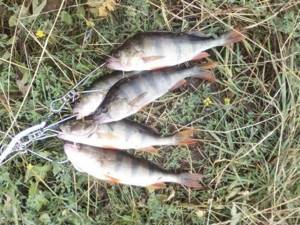
Photo 3. Large perch on spinning rod
Features of catching perch in the summer
In summer, perch behaves differently. For a good catch, you need to know many of its features, as well as the places where you can definitely catch it. As already mentioned, in hot weather it lives in holes, or where there is a lot of grass.
In areas where there is sufficient vegetation, individuals usually live in the morning or evening. And they stay at depth during the day, hiding from the heat.
They like to be where the bottom is uneven and there are large differences.
In ponds, perch can be in shallow water during the day, because there are plenty of fry there, as well as a lot of other food, such as shells, insects, worms, etc. This fish is an omnivore, so it eats whatever it finds.
In rivers, perch are slightly larger than in lakes or ponds. Since a sufficient number of all kinds of shells and bugs float along the current, which are necessary for its growth.
Promising places
River
Not deep sandy beaches with a quiet current, near thickets of grass. Tree branches hanging over the water and snags formed by the erosion of the bank with trees by the river flow.
Water structures, pontoon bridges, floating piers. In such places you can expect a good bite for small and medium-sized perch.
Deep holes at the end of the reach with shelters at the bottom, stones, sunken trees can bring a trophy specimen of a predator.
oxbow
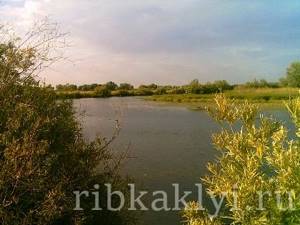
Usually, oxbow lakes are overgrown in shallow places with grass, water lilies, and egg capsules; hunting fish stick to these places. You can expect a bite both in thickets of water lilies and at the border of grass and clean water on a deep dump.
Lake
On lakes, perch also sticks to shallow places up to 4 meters with a clean sandy bottom and shelters and stones. Near reeds and vegetation.
Reservoir
Near reeds, the banks of flooded rivers, the border of clean water and algae. Clean places in thickets of aquatic vegetation.
Fishing methods: tackle and equipment
Perch can be caught using float tackle and spinning rods. Many anglers use each method.
Float tackle
Float tackle develops well, but still does not bring the same results and pleasure as spinning. If you are going to a pond for the first time and don’t know what the bottom is like and what species are there, then it is better to take a medium-power rod. The length should be 4 m. You can take it with or without rings. It all depends on the fisherman himself.
Fishing without rings is more dynamic . She trains the fisherman's speed and hooking. The line should be very thin. The leash is taken 2 times thinner than the fishing line. This gives a faster and smoother hook and consistency in action. The float should be short with a long keel. It should be used with a thin body. This makes it possible to see the smallest touches on the bait. It is loaded with a small weight that can withstand the carrying capacity of the float.
Bloodworms should be used as bait. It is more mobile in the water, and perch reacts better to it. You should take worms or maggots as a reserve. You can use many fertilizers. Sometimes it can be good for carp. The main thing is that there are more bloodworms.
You need a hook with a long shank. This way the fish will break less.
Spinning tackle
When fishing with a spinning rod, you need to be constantly on the move, so this type of fishing is much more interesting than float fishing.
The tackle should be no more than 10-11 grams.
6-8 grams is better. Thanks to this, you feel the adrenaline from every bite.
The reel is selected to match the stick. It should have a well-adjustable friction brake, good line laying and smooth running. The spinning rod should be very sensitive and move fast, and best of all, move regularly. This way the fish will break less.
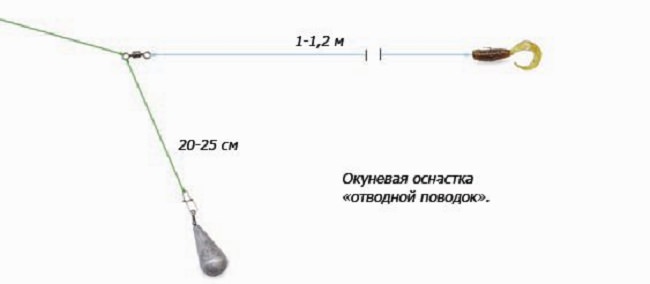
There are many ways to catch perch with a spinning rod, but the most effective is a retractable leash. To assemble such a tackle you will need a braided fishing line with a diameter of 0.13 mm, a pear weight, offset hooks and twisters of different sizes. You will also need fluorocarbon fishing line as a leash.
Everything is put together simply:
- A pear weight is attached to the end of the braid, the weight of which depends on the following reasons: what class of rod it is and at what depth the fishing will take place.
- After this, you need to measure 25 cm from the end of the fishing line where the load was tied and make a tightening loop.
- A fishing line 10-15 cm long is inserted into it and tied. After which the loop is tightened and the protruding ends are cut off.
- A hook with bait is attached to the outlet line. The size of the twister needs to be selected according to the size of the perch that lives in your fishing spot.
- The bait can also be lubricated with an attractant. This will increase the number of bites.
Catching perch with a drop-shot tackle
Drop-shot fishing is very popular among many fishermen, as it is characterized by ease of tying gear and effective biting. Using this method, not only predators, but also white fish are pulled out of reservoirs. In addition, assembling the tackle does not require large financial costs, and even a beginner can tie it.
The structure of the gear includes:
- A piece of fishing line 50-60 cm long, 0.18-0.3 mm thick;
- Hook;
- Smooth rounded weight with a separate eye;
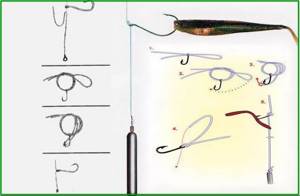
The offset hook is located directly on the main line, without requiring any additional leads. All equipment is fully adapted for fishing in hard-to-reach places, and the baited hook is almost completely unobstructed.
Experienced fishermen tie the tackle right before the process, but beginners are best prepared in advance. In calm conditions, while at home, tie on 3-5 rigs in order to be prepared for possible breaks.
Assemble tackle for drop-shot fishing in the following order:
- A piece of fishing line is attached to the main thread using a carabiner or using the “loop-to-loop” method;
- After 20-30 centimeters from the junction of the segment with the fishing line, a hook is tied with a special knot;
- A sinker is attached to the end of the main line, and the line is clamped in a special eye;
- Place the bait on the hook. Silicone fish are considered the best bait for this type of fishing. But perch can also bite well on an ordinary earthworm.
The ideal tactic for catching perch is considered to be a calm, smooth retrieve without sudden movements. A fast-moving bait will simply scare him away. The predator needs to be interested all the time, so the bait should be as natural as possible and look like a live fish.
What is a good way to feed perch?
When it comes to bait, fishermen are divided into two groups: those who believe that it is needed, and those who consider it a waste of time.
In fact, this predator has a keen sense of smell and a great interest in what is shiny and bright. Proper bait will increase your catch rate. There are many different baits available in fishing stores. But if you make it yourself, it will be much more interesting, and also more effective than many store-bought ones. For each season, fertilizing is done in different ways, but it must contain animal substance.
Technique for catching perch with a spinning rod
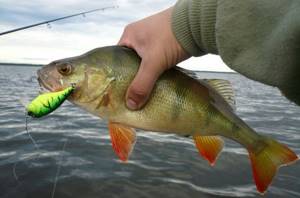
Let us immediately note that the activity of perch will be influenced by a number of factors, for example, weather conditions, the availability of food supply, and reservoir conditions. These are the main points that are important to consider when choosing bait and techniques for catching a predator.
Perch is best caught early in the morning and closer to sunset; the bite is not stable during the day, and is completely absent at night. Most often, perch can be found a few meters from the coastal zone, in shallow bays, as well as near thickets of surface and underwater vegetation.
You can determine the place where the perch feeds by the schools of small fish that jump out of the water or by the seagulls circling above the water, which pick up fry from the surface of the reservoir.
Having discovered such areas, you should immediately make several casts; if bites follow, then a good bite will be ensured.
The wiring is performed depending on the activity of the predator; if the perch is active, then after casting the wiring is performed slowly and evenly. It is important to note that the bait should be at a distance of up to half a meter from the bottom. If you conduct it in the thicker or closer to the surface, then the number of bites, even when catching an active perch, will significantly decrease.
If the perch bites are weak or when bringing the bait to the shore, the perch simply accompanies the bait, then you need to experiment with wiring. Having thrown the bait, we begin to perform light twitches with a smooth reeling.
You can try slowly, dragging the bait along the bottom, but you should not forget about pauses, the duration of which can reach 20 seconds. You can provoke a perch if you make sharp jerks combined with a pause. Note that most often the predator’s bite occurs during a pause; it is expressed in a barely noticeable blow, after which a sharp hook must necessarily follow.
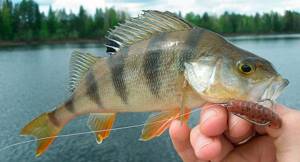
Video: Catching perch with a spinning rod
inf
Recipes for feeding for catching perch in summer
Recipe No. 1
You will need a bloodworm for this. You need to deliver it for fishing in silt, sand or soil, taken from the place where the future fishing will take place.
Bloodworms and solid mixture are taken in equal quantities , and dense balls are made from them. You can also use porridge instead of clay or sand.
Recipe No. 2
Have to take:
- 4 parts finely ground white clay,
- 1 part raw blood
- 5 parts crushed worms,
- 1 part crushed shell,
- 3 parts of any fish meat and
- 1 part bright and shredded tinsel.
The worms need to be kept in camphor oil and goose fat. Mix everything and make balls.
Recipe No. 3
Need to:
- 1 part honey and
- 3 parts chopped worms,
- 1 part blood
- 3 parts bloodworm,
- 5 parts clay and
- 1 part small scales.
Add 3 drops of lavender oil and the fertilizer is ready.
Properly selected feeding significantly increases the catch of this predator.
Tackle for summer perch fishing
Perch fishing in the summer provides a good opportunity to experiment with a huge number of tackles and baits.
Spinning
Spinning is one of the most popular gear for catching striped predators. For catching perch in the summer with a spinning rod, light class rods with a weight of up to 10-12 grams are mainly used - this is provided that you fish with spoons and cranks. For twitching wobblers we use tackle of the same class, but with a medium-fast action. And “Ultralight” for microjig.
The length of the spinning rod is selected based on the fishing characteristics. If you catch perch from a boat, then use a medium or fast action rod, no more than 2.1 m long. For fishing from the shore, we take a slow or medium action rod, 2.1-2.7 m long.
Equipment
The reel is selected in accordance with the parameters of the fishing rod, but in the case of perch its size most often ranges from 1000 to 2500 according to the Shimanov classification.
The fishing line most often used is monofilament, with a diameter of 0.2-0.25 mm. There is no fundamental difference in whether to use mono line or braid. However, a number of anglers stubbornly stick to braided lines, explaining that jerk wires are best suited for perch. And they are much easier to perform with braided fishing line.
Lures
There are a huge variety of spinning baits used for summer perch fishing.
Spoons
However, spinners are considered the most effective. Among them, many speak positively about the Mepps and Blue Fox line of spinners. Spinner baits with red petals and dark dots have proven themselves especially good. They are best used in shallow water areas with little aquatic vegetation.
Oscillating spoons, unlike spinners, are less effective, but they have a clear advantage - they are more often used to catch large perch in the summer. If we talk about specific models, then we can recommend the popular “Kastmaster”, as well as “Toby” from. Their wiring is mostly uniform or bottom jig.
Wobblers
These baits have also proven themselves well; minnows or poppers of small sizes and bright colors are mainly used. Fast wiring is recommended, with short pauses or no stops at all.
Silicone baits
Here, as a rule, twisters and light vibrotails equipped with jig heads are used. The fisherman is only required to experimentally select the correct color and size of the bait itself. It is in the case of these baits that fishing for perch on a retractable leash can be especially effective, allowing you to survey large areas.
Note to anglers:
Regarding the colors of perch spinning lures, it is recommended to adhere to the following:
- Cloudy weather, great depth - use bright and acidic colors
- Partly cloudy – red hues lure
- Sunny weather – orange, green and golden colors of baits
Float rod
For catching perch in the summer with a float rod, both fly and match rods are widely used. Flying tackle is used more often when fishing from a boat or from the shore at a short distance. If you need long casting or you are purposefully catching a large perch, then the best solution would be match gear.
Equipment
The rigging of a fly rod is not anything complicated - usually it is a blind fastening of the fishing line to the tip of the rod. If we talk about a match fishing rod, then a reel with a supply of fishing line is already used. The float is loaded in such a way that it is always in a vertical position, regardless of the type of bait used.
Lures
Perch is caught exclusively using bait of animal origin. Dung worms, bloodworms and maggots are mainly used. And, of course, you should not neglect such bait as live bait. For perch, the fry of the following fish are preferred:
- Bleak
- Verkhoplavka
- Minnow
The length of the live bait should be no more than 4-5 cm, since the perch does not attack too large prey.
Nuances of choosing bait
Baits for perch are very diverse. In particular, they use rotating and oscillating spoons, cicadas and spinnerbaits, as well as silicone baits:
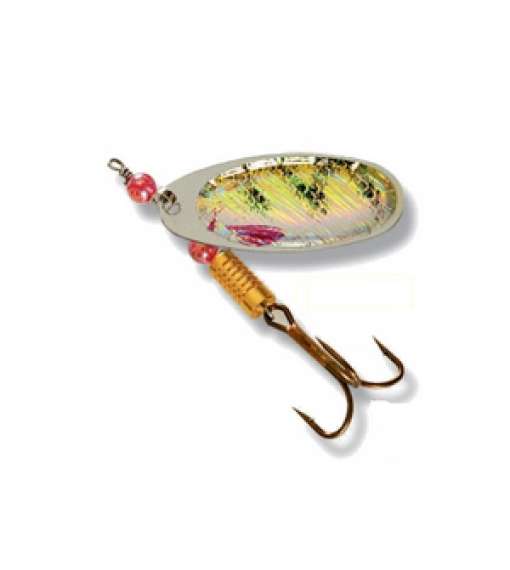
Spinner
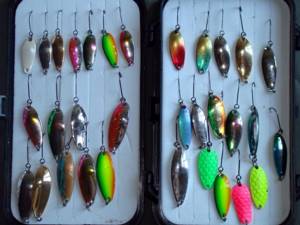
Oscillating spoons
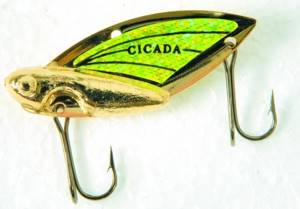
Cicada
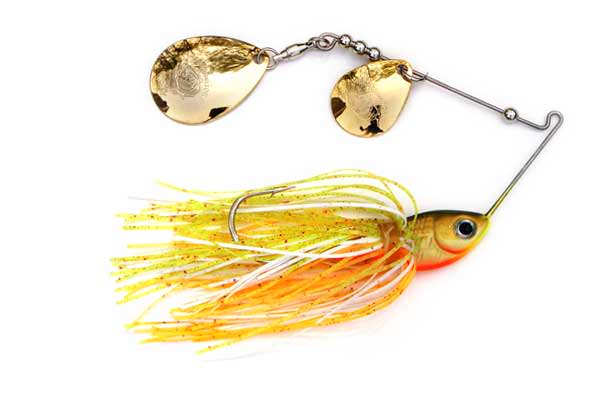
Spinnerbait with two blades
- Rotating spoons . This is a classic for perch fishing. They are very popular, and for good reason. The shape and size of the petal, as well as the color, can affect the catch. Bright lures are effective in rainy weather, while dull lures are used in daylight.
- Oscillating spinners . To catch a predator, you need to take oscillating spoons measuring three to five centimeters in size when fishing. This bait is best used at the bottom of a reservoir. The perch, seeing that someone is fussing around the bottom, reacts to this.
- Cicadas and spinnerbaits . When a cicada gets into the water, there is a big stir among waterfowl. When fishing with it, you can be sure of 100% success. The high-frequency play of this bait will not leave the perch indifferent. Small spinnerbaits create great vibration in the water, since it is both a silicone and rotating bait. The predator simply has to punish the noisy fish as he sees fit.
- Silicone baits . It is mainly caught using silicone at great depths, where large individuals live. The most important thing is to choose the size of the bait, and if the perch is active, it will definitely be caught.
Bait mounting methods
Jig
Jigs used in fishing are used taking into account the test form, which is indicated on the body of the fishing rod. The best test is considered to be a test up to 10 grams. Using a leash is not advisable; rare bites from small pike do not cause much harm to the gear, and the number of bites increases. The jig is tied directly to the fishing line or cord using any available knot.
Retractable leash
A weight is attached to the main cord. The weight of the cargo depends on the fishing location, and is selected based on the presence of current and the depth of the reservoir. It can range from 5 to 10 grams on ultralight and 10-30 grams on other types of spinning rods. Above the sinker, at a distance of 30-50 cm, a leash is knitted (the best leash material is fluorocarbon 0.18-0.3 mm dm) for 1-1.2 m. The best hook is considered to be an offset hook tied to a leash, although simple ones with a long shank are also suitable.
Drop shot
A relatively recently used method, the equipment is similar to a retractable leash, only the hook is attached directly to the main fishing line or cord. The hook can be a special one, or a regular medium-sized shank; it is possible to use an offset one. If the diverting leash is good in the current, then the drop shot, due to the increase in the weight of the load, works both in the current and in calm water. Another positive quality is the ability to fish at distant points with a sharp drop, which a regular jig passes very quickly. By placing two or three baits of different sizes at some distance from each other, you will be able to quickly determine the catching one.
Donka
Donka believes passive fishing. Assembled on the basis of a reel or spinning rod. A weight weighing from 40 to 80 grams is attached to a thick fishing line at one end; above, after 15-20 cm, 10-15 cm are 2-3 leashes made of monofilament with a diameter of 0.5-0.6, to which hooks with a long shank are attached.
They catch her like that
The load with hooks is removed from the reel and the fishing line is usually 15-20 meters long, maybe longer. Bait or live bait is put on the hooks. The fishing line is taken with one hand above the last hook, raised, the load with the hooks comes off the ground, swings and is thrown into the fishing spot.
To determine the bite, the fishing line is attached to a previously inserted, peeled willow or tala branch. Then any signaling device, preferably a bell, is hung on the fishing line. After the bite, the tackle is pulled out of the water by hand, carefully placing the fishing line nearby in a clean place. The fish is removed, the bait is changed, and the donk is cast again.
A spinning rod is assembled in exactly the same way, but it is easier to fish for it, since the fishing line is wound onto the reel when fishing, and unwinds from it when casting.
Zherlitsa
There is no special fishing for perch in the summer with girders; most often it is caught in the bycatch of pike or pike perch. Zherlitsy can be factory-made or home-made. Most often, factory ones include mugs and slingshots.
Circle
A circle of round foam plastic or a hollow plastic flattened cylinder with a slot along the side edge for winding fishing line. In the center of the disk there is a hole for a bite alarm pin.
A line of 15 meters is wound around the circle into the slot, a hook is tied to the end and a weight, 15-20 grams, is 15 cm above the hook.
A fisherman on a boat sails to a promising place. He attaches the bait to the hook and unwinds 2-2.5 meters of fishing line and attaches it to the long side of the pin. Live bait with a load is lowered into the water. The fisherman swims about thirty meters from the girder and watches the bite, which is determined by turning the circle over with the long side of the pin into the water. Further actions depending on the circumstances. You can wait until the predator takes the bait thoroughly, or you can try to hook it right away.
You can also catch white fish with a circle by changing the weight of the load, hook size and bait.
Slingshot
They catch it with a slingshot from the shore, tying it to overhanging tree branches or a long stick.
There are other types of girders.
Techniques and tactics for fishing
The result of the catch depends not only on the correctly selected gear and bait, but also on technique and tactics. When fishing, you need to take into account the time of day, the depth of the reservoir, the current, and more.
- Professional fishermen advise feeding the area in advance . If this is done, then on the day of the catch, feeding should be given in smaller quantities.
As soon as fishing begins, you should not immediately throw bait into the center of the hole. First you need to work the edges. This way the perch won’t get scared and won’t swim away. It is better to do the first postings at a fast pace. This will let you know if fish are active there. If predators do not react, then the speed must be reduced. Explosions and dragging along the bottom are also carried out.
- Sometimes a change in the color of the bait, not the character, but the color, has a good effect on the perch . This is where the irritating factor comes into play. The perch bite looks like constant poking. You need to know that there will be a lot of idle bites, and here the fisherman’s skill needs to be improved all the time. And of course, fishing with a spinning rod will be the most effective.
- The best time of day for fishing in summer is morning or evening . There is also activity during the day, but the specimens will be small. The bait should always be mixed with soil or clay taken from the pond itself. This way the predator will not smell other odors. The best bait, of course, is a wobbler. Its game is very similar to real fish.
By following all these recommendations, even a novice fisherman will come across large specimens of this predator.
Fishing with live bait
Live bait fishing is the best way to catch big bass. In addition to the popular float rod, catching perch in the summer with live bait is carried out with summer jigs and mugs. The live bait is small fish caught in the reservoir where fishing is planned.
How to catch perch using summer baits
Fishing with summer girders is possible on sections of the coast where steep slopes or coastal holes are identified. The bait is equipped with an additional weight, the weight of which will hold the fish in the bottom layer of water. The length of the leash should ensure free movement of live bait above the bottom surface. 30-50 cm is enough.
The reel of the vent is secured to the shore in any convenient way. A bite alarm is installed. They can serve as a piece of fabric with a bright coloring, which is attached to the line clamp on the reel. If you find the gear “at hand”, after the alarm has been taken under water, you should not make an instant hook. Perch usually reliably hook themselves.
Catching perch with mugs
Using a boat, perch fishing with circles is available in summer. A carp circle is suitable for catching large striped predators. The equipment is assembled for attaching live bait. If the fish is attached under the fin, by the lip or under the winding of the thread in the tail, then we use a single hook. To attach live bait through the gills from the mouth, it is advisable to tie a tee.
After “charging” the gear, instead of passively waiting for a bite, fishing can continue with a spinning rod or a float rod. The main thing is to position the boat so that all the gear is in sight.
So, with careful preparation for catching large perch, you can count on a positive result. Fighting fish while fishing brings a lot of positive emotions.
